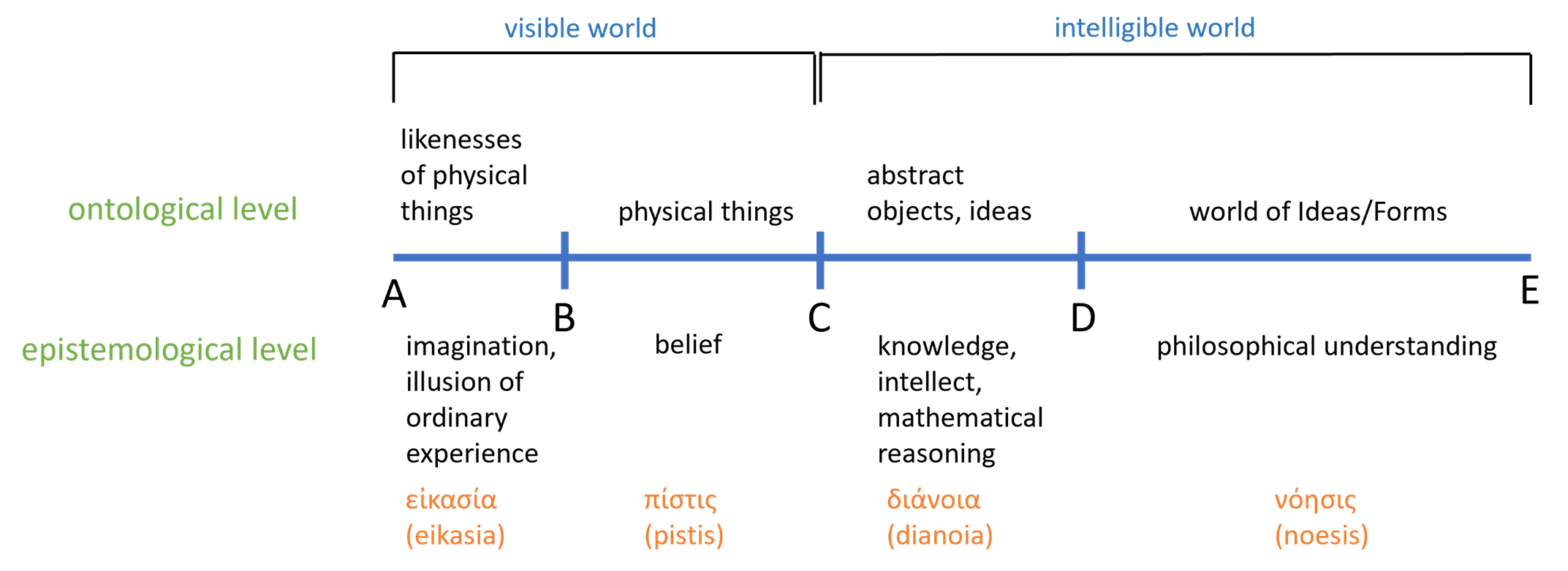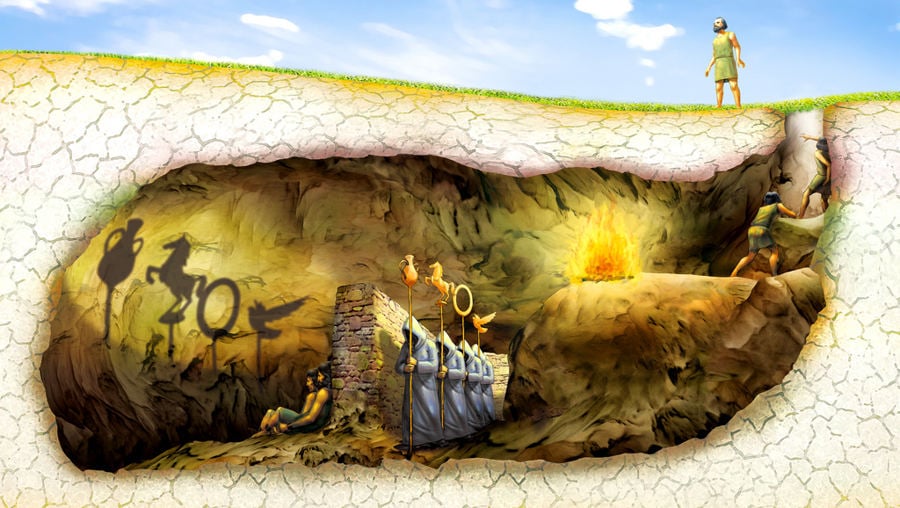
This blog discusses ideas and concepts that I am currently thinking about for my book on Hyponoetics as an integral philosophy of mind and matter.
Types of Knowledge
The following Greek philosophers used visual analogies to illustrate the different types or stages of knowledge in the human mind. What is common to these analogies is that the highest knowledge is a comprehensive, holistic or integrated understanding of the whole and is closest to objective truth. It is an intuitive knowledge or direct insight of the wise man or philosopher.
Parmenides
Parmenides presented a foundational philosophical distinction between two paths of inquiry in his surviving poem, often referred to as On Nature. These are known as the "Way of Truth" (ἀλήθεια: aletheia) and the "Way of Opinion" (δόξα: doxa).

αἵπερ ὁδοὶ μοῦναι διζήσιός εἰσι νοῆσαι.
ἡ μὲν ὅπως ἔστιν τε καὶ ὥς οὐκ ἔστι μὴ εἷναι,
Πειθοῦς ἐστι κέλευθος (ἀληθείηι γὰρ ὀπηδεῖ),
ἡ δ’ ὡς οὺκ ἔστιν τε και ὡς χρεών ἐστι μή εἷναι,
τήν δή τοι φράζω παναπευθέα ἔμμεν ἀταρπόν.
οὔτε γὰρ ἄν γνοίης τό γε μἠ ἐόν (οὐ ἀνυστόν)
οὔτε φράσαις.
(Fragment 2)
What routes of inquiry alone there are for thinking:
The one - that [if] is, and that [if] cannot not be,
Is the path of Persuasion (for it attends upon truth);
The other - that [if] is not and that [if] needs must not be,
That I point out to you to be a path wholly unlearnable,
For you could not know what-is-not (for that is not feasible),
Nor could you point it out.
The "Way of Truth" is the path of rational inquiry, accessible only through reason, and it reveals the true nature of reality as a single, unchanging, eternal, and indivisible whole. Parmenides argues that true being is timeless and uniform, and that change, plurality, and motion are illusions. He asserts that "what is" must exist eternally and cannot arise from "what is not," and that the very possibility of thought or speech depends on the existence of something that is. The central principle of this path is that "whatever is is, and what is not cannot be," and that "the same thing is for thinking and for being". This leads to the conclusion that the only coherent thought is that which affirms existence, as non-being cannot be thought or spoken about.
In contrast, the "Way of Opinion" deals with the deceptive appearances and beliefs held by mortals, which are based on sensory experience and are therefore unreliable and illusory. While Parmenides acknowledges this path as a way to understand the world of appearances, he considers it a path of falsehood and deception, leading to flawed thinking. Although only fragments of this section survive, it is understood to contain a cosmology that explains the world as perceived through the senses, despite being fundamentally at odds with the truth revealed by reason.
Parmenides argues that true knowledge can only be attained through rational thought, dismissing sensory experience as unreliable and illusory.
Zeno of Citium
Zeno said that there were four stages in the process leading to true knowledge, which he illustrated with the example of the flat, extended hand, and the gradual closing of the fist:
Nam cum extensis digitis aduersam manum ostenderat, 'uisum', inquiebat, 'huius modi est'. Deinde, cum paulum digitos contraxerat, 'adsensus huius modi'. Tum cum plane compresserat pugnumque fecerat, comprehensionem illam esse dicebat: qua ex similitudine etiam nomen ei rei, quod ante non fuerat, κατάληψιν imposuit. Cum autem laeuam manum admouerat et illum pugnum arte uehementerque compresserat, scientiam talem esse dicebat, cuius compotem nisi sapientem esse neminem.
[Cicero, Academica, 2.145]
For when he stretched out his fingers, and showed the palm of his hand, “Perception,” said he, “is a thing like this.” Then, when he had a little closed his fingers, “Assent is like this.” Afterwards, when he had completely closed his hand, and held forth his fist, that, he said, was comprehension. From which simile he also gave that state a name which it had not before, and called it κατάληψις. But when he brought his left hand against his right, and with it took a firm and tight hold of his fist, knowledge, he said, was of that character; and that was what none but a wise man possessed.
This analogy was used to convey that knowledge is not merely a passive reception of impressions but an active process involving assent and firm grasp, culminating in the integrated understanding characteristic of the Stoic Sage.
 The hand is held open, at a distance, with palm upwards, to symbolize a superficial impression or “presentation”,
prior to assent being given. The Greek term is φαντασία (phantasia) = appearance, imagination, presentation to consciousness,
impression, perception in general.
The hand is held open, at a distance, with palm upwards, to symbolize a superficial impression or “presentation”,
prior to assent being given. The Greek term is φαντασία (phantasia) = appearance, imagination, presentation to consciousness,
impression, perception in general.
 The hand is closed loosely, to symbolize initial “assent” or agreement with the idea.
The Greek term is συνκατάθεσις (synkatathesis) = assent, approval, agreement.
The hand is closed loosely, to symbolize initial “assent” or agreement with the idea.
The Greek term is συνκατάθεσις (synkatathesis) = assent, approval, agreement.
 The hand is squeezed tightly into a fist to symbolize a firm grasp or sense of certainty, assent has been given to
it as an “Objective Representation”. The Greek term is κατάληψις (katalepsis) = seizing, grasping, direct apprehension
of an object by the mind, comprehension.
The hand is squeezed tightly into a fist to symbolize a firm grasp or sense of certainty, assent has been given to
it as an “Objective Representation”. The Greek term is κατάληψις (katalepsis) = seizing, grasping, direct apprehension
of an object by the mind, comprehension.
 The fist is enclosed tightly in the other hand, to symbolize the perfect “knowledge” of true ideas attained by the
ideal Sage, which is elsewhere described as an interconnection of firmly-grasped principles.
The Greek term is ἐπιστήμη (episteme) = knowledge, secure understanding.
The fist is enclosed tightly in the other hand, to symbolize the perfect “knowledge” of true ideas attained by the
ideal Sage, which is elsewhere described as an interconnection of firmly-grasped principles.
The Greek term is ἐπιστήμη (episteme) = knowledge, secure understanding.
Plato
Unlike perception and intellect, intuition is not bound to the sensuous phenomena of our experience and that way, it can obtain direct insight into the essence of things. This idea is dominant in Plato as the doctrine of the different levels of cognition which correspond to different ontological levels. The analogy of the divided line (Republic, 509d–511e), as it is called, can be represented visually like this:

The highest level of truth is through philosophical understanding (DE), or the direct intuition of the Platonic Ideas or Forms (noesis). Like in Plato’s analogy of the cave (Republic, 514a–520a), our ordinary experience only gives us access to the “shadow” of reality (AB), which entails opinions and beliefs (BC). We have to advance to the intelligible world of the intellect and knowledge to obtain a deeper understanding of the world in terms of abstract concepts and ideas (CD). This is equivalent to what we call analytical thinking. Only noesis, or intuitive cognition (DE), attains the highest truth and reality of the world. The word 'νοῦς' or 'νόησις' is used for the faculty whereby we have direct intellectual vision of reality without any help from the senses such as is present even in διάνοια (compare Republic, 511d).
Plato's Allegory of the Cave, presented in his work Republic (Book VII, 514a–520a), is a philosophical metaphor illustrating the difference between perceived reality and true knowledge.

It depicts prisoners chained in a cave since childhood, facing a blank wall, unable to turn their heads. Behind them is a fire, and between the fire and the prisoners is a low wall; people walk along this wall carrying various objects, including puppets, which cast shadows onto the wall in front of the prisoners. The prisoners, having never seen anything else, believe these shadows are the only reality, and they name the shadows based on the sounds they hear from the unseen people behind them.
When one prisoner is freed and forced to ascend from the cave into the sunlight, the experience is initially painful and disorienting. The bright light blinds him, and he struggles to see the real objects, reflections in water, and eventually the sun itself. Only after his eyes adjust can he perceive the true source of light and understand the nature of reality, recognizing the sun as the source of all life and truth. This journey symbolizes the philosopher's path from ignorance to enlightenment, where true knowledge is gained through reason and the understanding of the Forms—the highest and most fundamental reality.